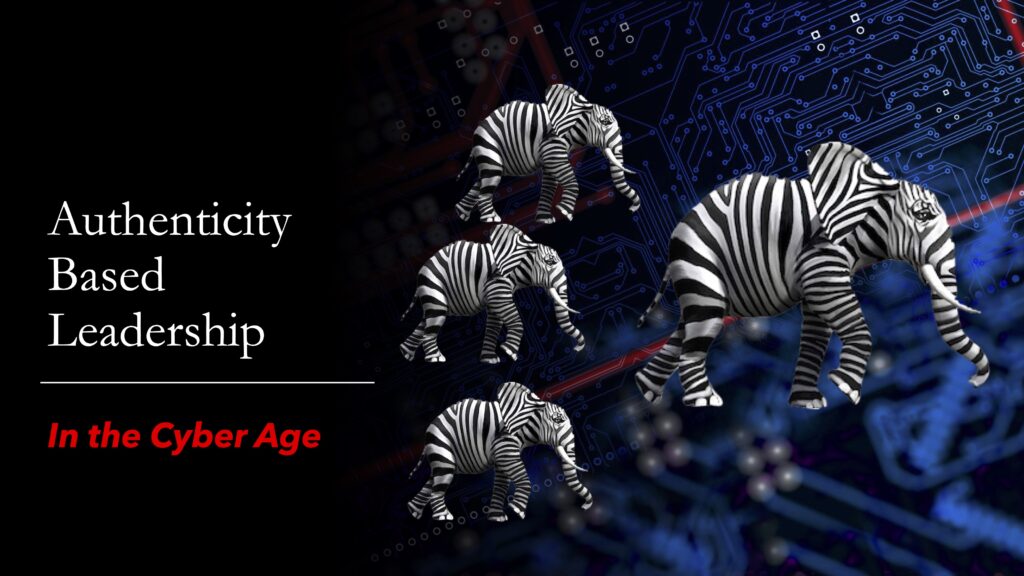
A Paradigm Shift in how to Acquire, Develop, and Lead Talent
The Problem
How often have you felt your talent was underutilized or even ignored? Does your career allow you to be your best self or are you just filling a seat to get a paycheck?
Those are questions cyber age employees ask whether they are team members or executives. People today want fulfillment, not just a paycheck.
So, if you are a leader who wants to acquire, develop, and manage the best talent, you’ll need to change how you think about talent and its benefits to the productivity of your organization.
The Cyber Age talent crisis can only be resolved by a paradigm shift to authenticity-based leadership.
Terms
Accurately defining the problem is part of the solution. The following terms are defined to ensure no false assumptions exist.
Talent
Talent means the natural capacity, power, or ability of a person. It is inborn. Neither you, nor anyone else initiated the talent.
A skill, by contrast, is something that must be learned. A skilled person needs to be motivated or incentivized to improve their skills for which they have no talent, while a talented person possesses the passion to develop their talent. That is because the desire to become the best in their field comes with the talent. A talented person finds using their talent easy and fulfilling, while a person who is only skilled usually finds their work laborious and exhausting. Talent is by nature creative and innovative, not so with a person who is merely using skills.
Everyone has a talent, though most have no idea what it is. Consequently, skills are more often referred to in the workforce than talent. Would you rather have a skilled person—who probably needs constant motivation and incentives—on your team, or a talented person that is passionate and has the desire to be the best in their field?
Cyber age
Cyber age refers to this current era, and is characteristic of computers, information technology, virtual reality, and artificial intelligence. The cyber age was preceded by the information age, which was preceded by the industrial age. While technology, data, and innovation continue to move forward at an ever-increasing pace, the management theory and practices used by most organizations are still stuck in the industrial age.
The cyber age has changed the nature of work as well. Remote learning, remote working, and virtual conferences and webinars are now a permanent part of the cyber age. To be successful in the cyber age creativity and innovation are a must. These attributes require employees that adapt quickly to change, and leaders that can tap into the strengths of those that work for them. It requires higher levels of cooperation and small unit leadership than any previous age.
Authenticity
Authenticity is the quality of being real or genuine, true to one’s personality, spirit, or character, and being without deceit or hypocrisy. To be authentic one must really know oneself, which few people do. A major aspect of being authentic is knowing your God-given talent and desiring to use it. Authenticity is required by both leaders and followers to resolve the cyber age talent crisis.
Discussion
According to Gallup, what the people of the world want more than anything is a great job; one that provides more than enough money to live on, one that is stable, one that allows them to use their talent, in a workplace to which they enjoy going. And the greatest perk to a cyber age employee is not games in the lunchroom, not necessarily higher pay, but flexibility in their work life.
That desire of people—wanting a great job—presents a few challenges. First, one needs to know their talent is to use it in a job. Instead, most people have no idea what their talent is and spend no time or energy in trying to discover it. They drift through life hoping to survive from one paycheck to the next, with no purpose or direction.
Second, to have a great job, one needs to work for an organization that appreciates talent, can develop it, and has leaders that can direct it for organizational success. That kind of organization requires leadership that is engaged in talent acquisition, development, and management, and that not only has a vision, but communicates their vision to the people in the organization. Instead, most leaders (whether in a company, a church, or the military) show little interest in developing talent. And yet it is the talent of people that drives all creativity, innovation, progress, and productivity.
The result of this situation is that many cyber age employees are stuck in a survival mode. The idea of having a great job is just a myth to them, so getting by from one week to the next becomes their life. Cyber age employees are more prone to depression and loneliness than previous generations, and their rate of suicide is epidemic. These are the results of no hope and no purpose.
Their untapped potential is often removed from the workforce because they can make more money by not working than by working at an under compensated job. According to the Foundation for Government Accountability, “Today, an unemployed parent with two kids who previously worked at a low-income job could collect more than $3,700 per month—nearly $45,000 per year—in government benefits, more than the wages of the average job.” If that is what you have been conditioned to expect, then why bother looking for a great job? Why bother trying to discover your talent? Why work at a place that doesn’t give you any fulfillment when you can make more money doing nothing?
Many current day leaders have been trained in industrial age management theory, and only see the people in their organizations as assets. Their view of leadership is to use people (their assets) to perform a task to provide a profit. When this doesn’t work, real productivity, creativity, innovation, and organic growth are often substituted by reducing costs (overhead and labor) to increase profits. And when organic growth becomes too difficult under these conditions, it is replaced by mergers and acquisitions. This shortsighted view gives profit has a higher priority than talent.
The Paradigm Shift
That description of the workforce and leaders does not apply to everyone, but it applies to enough people to create a net negative effect on talent acquisition and development. The situation is dire. A paradigm shift in how to acquire, develop, and manage talent is required to overcome this crisis.
Assuming Gallup’s data is correct, and what employees want most is a great job, then you may ask, “How do I provide great jobs for the talent my organization seeks? Jobs which develop their talent, jobs that pay more than enough, that provide an environment in which my employees want to work, and in which they can continue to grow?” And, probably more importantly, “Is that kind of change worthwhile?”
These are questions asked by all four branches of the military and by leaders in the business world. And while the Church may not express the issue in the same way as the military or businesses, all denominations are facing a mass exodus of people (talent) from their organizations.
Gallup, ADP, the Harvard Business Review, and numerous other research institutions have gathered data that all say the same thing. The question of whether there is a talent problem, not just in the United States, but worldwide, is no longer debatable…it is a fact. And the problem has a solution, but it requires a paradigm shift in thinking.
So why haven’t real solutions been implemented? The evidence suggests that while the world of talent, innovation, creativity, and productivity have radically changed over the last two decades leadership and management theory have not. We are now living in a cyber age, having just flown through the information age, but leadership and management are still the products of industrial age thinking. The world has changed, but leaders, and not just American leaders, have not.
The dilemma that leaders cannot seem to figure out is this: How can the population continue to grow without there being enough workers to fill vacant positions? The answer is obvious: Workers don’t want your jobs. They want something else.
Leaders seem to expect job seekers to change. After all, they should want a job to make money, right? This gets right to the heart of the issue. People today no longer want just any job, especially when the government will pay them to do nothing. They want a great job. Leaders need to understand this. Leaders need to provide great jobs…great in the minds of the workforce, not in the minds of the organizational leaders. And leaders need to provide great jobs not just to appease their employees, but because great jobs lead to greater productivity, which leads to greater profit.
Gallup’s State of the Global Workplace for 2022 found that 67% of the US workforce was disengaged, while 79% of the worldwide workforce was disengaged. That means that the vast majority of the population is not using their talent at work (if they even know their talent). Gallup’s data shows that the largest factor in determining whether a person is engaged in their work is the manager for whom they work. They put the blame for lack of engagement of the workforce squarely on the shoulders of managers.
Even the fact that we call people “managers” is part of the problem. Referring to a person that is responsible for the productivity of other people a “manager” is a leftover from the industrial age. Managers manage assets (owned property), while leaders lead people. Most of the positions we commonly refer to as managerial positions are actually team leaders. While this may seem a small point, it is at the heart of the cyber age talent crisis. And while there remain managers in organizations, they manage assets or numbers, not people. Calling a team leader a “manager”, or employees “assets” is a remnant from when the workforce was regarded as the property of a company, property which could be replaced at will. That is no longer the case. Instead organizations have team leaders instead of managers, and employees are team members not assets.
Therefore, to restate the problem;
- The workforce does not know their talent—their natural ability and how to use it.
- Team Leaders do not know the talent of their team members, and probably don’t know their own talent either.
- Many team leaders possess no talent to lead—they should not be in positions of leadership.
- Team leaders have not been trained how to lead people, how to capitalize on the talents of their teams.
- Leaders (CEOs) are not normally engaged in talent acquisition, development, or management
- Those tasks are normally delegated.
- Interviews relying on resumes and past performance are poor indicators of talent.
- Without direct involvement by leadership in the talent process nothing will change. If the leader does not buy into the paradigm shift, no shift will take place.
Solution
Step 1
The first step in the solution to the cyber age talent crisis is to recognize that the world has changed. Recognizing the fact that the talent of people is required for the innovation and creativity demanded of organizations is a great leap from management theories of the industrial age. No longer are employees an expendable commodity that can be replaced at will.
Both the military and corporations are beginning to recognize this fact. Where once there was an ample supply of young recruits to fill the ranks or workforce, now those same young people are looking for, and expecting something more. They want purpose, they want development, and they want a living wage. They don’t want a boss; they want a coach and a mentor. By providing purpose, development, and mentorship with a reasonable salary the military and corporations can accomplish three things: They will attract more recruits, they will increase retention, and they will increase productivity.
The biggest reason people leave an organization to search for a different job is they feel there is no development in their current position. This holds true regarding the military, a company, or a church, and it applies to both workers and executives. Employees in the cyber age all want purpose, they want development, they want a living wage, they want a degree of flexibility, and they want a coach, not a boss.
The research shows that organizations that provide the things cyber age employees want results in higher employee engagement. Engaged employees use their talents to be more creative and innovative in their jobs. This results in higher productivity and greater profits. While it may seem to be a monumental task to provide what workers want, the results are worth it.
Step 2
Next, a shift in how talent is acquired is necessary. Resumes and past performance (often unverifiable) are poor substitutes for an accurate assessment of a person’s talent. If their resume and past performance are so great, why are they looking for a new position? How do you know they will be a match for your team?
To acquire the right talent for your organization two things are required. First, you need to define the kind of talent that is required for your team. What natural abilities and thinking processes would best fit that position? Second, you need to assess the talent of potential employees. Just because someone did the job in the past, has a degree, or a certificate in an area, does not mean they are talented in the area you want.
Talent assessment tools are already available with substantial data to back their claims of validity. Unlike aptitude tests or personality assessments, talent assessments determine a person’s talent and the unique way they think. An aptitude test determines whether a person can do a certain task, however, just being able to do a task is no indicator of being talented. Likewise, personality tests do not determine talent. They are designed to assess people’s behavior. Both aptitude and personality assessment are valuable tools, but not in assessing talent.
In Good to Great, Jim Collins says that great organizations first get the right people on the bus, and then get them in the right seat. The idea is that finding the right talent for your organization is of paramount importance. But that is just the beginning. Placing talent in the right positions, and possibly creating new positions for the right talent, and continually developing them is the next step. And finally, directing them through team leaders to focus their talents on productivity that benefits the organization is what enables the vision of the organization to be fulfilled.
Step 3
The Leader must be a part of the solution at every level. If the leader of the organization is not engaged in the talent acquisition and development of all employees nothing will change. It must be his or her priority. In the cyber age the creativity and innovation of talented people is what make successful organizations, and authenticity-oriented leadership is a must.
At the core of every organization are team leaders. Team leaders direct the talents of those in their charge. This implies that team leaders must have the requisite talent to lead, and they must be trained and developed in their ability to direct the talents of others. Who you choose to be team leaders cannot be the result of seniority. If they do not have a talent for leading others, then putting them in such a position would adversely affect the team.
Not all team members will make good team leaders. Those without a talent for leadership can be promoted to positions based on their expertise, or they can stay in their team with salary increases as appropriate, but they should not lead others. Not everyone wants to lead, nor should they. Many employees just want their great job to be all about the people they work with, how they are treated by their leader, and the vision of the organization.
Conclusion
According to a Jan 9, 2020 issue of the Harvard Business Review, the best leaders have “the ability to
see talent before others see it, unlock human potential, and find not just the best employee for each role, but also the best role for each employee.” Great leaders in the cyber age must be great talent agents.
The article goes on to say that the two biggest mistakes leaders make when evaluating other people’s talents are:
- focusing too much on their past performance (even when they lack reliable metrics)
- overrating the importance of their resume, hard skills, and technical expertise.
Instead, leaders need to recognize they will be better equipped for the future with teams that are led by team leaders trained to optimize the talents of their people.
The cyber age is radically different than any previous age. The rapid rate of change in society, technology, and geopolitics, together with the changes in the workforce combine to create the need for a paradigm shift in our approach to a talent solution. It is no longer reasonable to treat people as assets that must adapt to the demands of organizations for which they work, as was the case in the industrial age and information age.
Today’s leaders must become talent agents. The right talent on your team is what drives creativity, innovation, productivity, and profit. In a very real sense talent has become the new currency of the cyber age. Authenticity-based leadership can solve the cyber age talent crisis. Those that shift their thinking to this new reality stand to gain the most.


